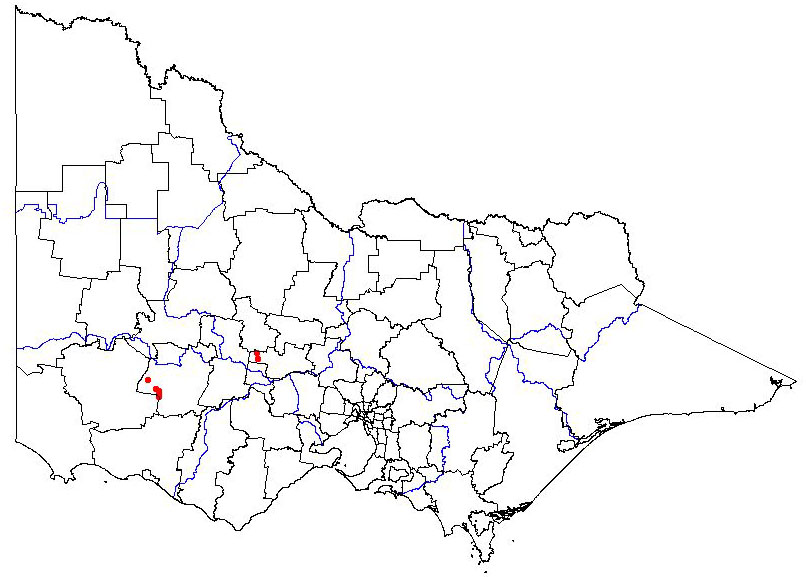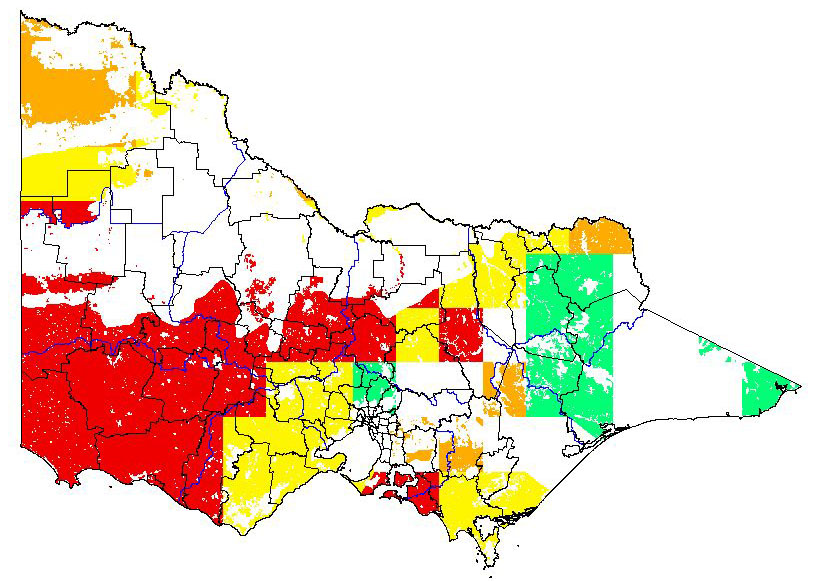Cretan rockrose (Cistus creticus)
Present distribution
|  Map showing the present distribution of this weed. | ||||
| Habitat: Native to Southern Europe, Northern Africa and Western Asia. Reported in various fire prone habitats, from shrubland to forest, from coastal to mountain slopes, also reported as persistent in slashed grass. | |||||
Potential distribution
Potential distribution produced from CLIMATE modelling refined by applying suitable landuse and vegetation type overlays with CMA boundaries
| Map Overlays Used Land Use: Forest private plantation; forest public plantation; pasture dryland. Broad vegetation types Coastal scrubs and grassland; coastal grassy woodland; heathy woodland; lowland forest; heath; box ironbark forest; inland slopes and plains; sedge rich woodland; dry foothills forest; montane dry woodland; sub-alpine woodland; grassland; plains grassy woodland; valley grassy forest; herb-rich woodland; sub-alpine grassy woodland; montane grassy woodland; riverine grassy woodland; rainshadow woodland; mallee; mallee heath; boinka-raak; mallee woodland; wimmera / mallee woodland Colours indicate possibility of Cistus creticus infesting these areas. In the non-coloured areas the plant is unlikely to establish as the climate, soil or landuse is not presently suitable. | 
|
Impact
QUESTION | COMMENTS | RATING | CONFIDENCE |
| Social | |||
| 1. Restrict human access? | It is a plant that can form a dense scrub, and the excaudate has been linked with cases of dermatitis, therefore has nuisance factor (Garcia-Gonzalez et al 2001). | mh | mh |
| 2. Reduce tourism? | Planted as an ornamental. | ml | m |
| 3. Injurious to people? | Has been linked with dermatitis (Garcia-Gonzalez et al 2001). | ml | mh |
| 4. Damage to cultural sites? | No reports of structural damage however there is an attempt to control it and another cistus at the Clunes cemetery therefore must have at least an aesthetics issue (Clark 2005). | ml | mh |
| Abiotic | |||
| 5. Impact flow? | Terrestrial species | l | m |
| 6. Impact water quality? | Terrestrial species | l | m |
| 7. Increase soil erosion? | Used for erosion control in its native range however the requirement of fire for regeneration would leave the soil fully exposed for a time (Gokturk, Olmez & Temel 2006 & Guven 1985). | ml | m |
| 8. Reduce biomass? | A successful competitor (Vulliamy, Potts & Willmer 2006). | ml | m |
| 9. Change fire regime? | Requires fire for regeneration, also pre-drought leaf fall would increase leaf litter and therefore fire hazard just prior to summer (Grammatikopoulos 1999). | ml | m |
| Community Habitat | |||
| 10. Impact on composition (a) high value EVC | EVC= Creekline Grassy Woodland (E); CMA Glenelg Hopkins; Bioreg= Glenelg Plain; VH CLIMATE potential. Can become dominant leading to lower floral diversity especially in the herb layer. Major displacement of dominant sp. within a layer. | mh | mh |
| (b) medium value EVC | EVC= Heathy Herb-rich Woodland (D); CMA Glenelg Hopkins; Bioreg= Glenelg Plain; VH CLIMATE potential. Can become dominant leading to lower floral diversity especially in the herb layer. Major displacement of dominant sp. within a layer. | mh | mh |
| (c) low value EVC | EVC= Lowland Forest (LC); CMA Glenelg Hopkins; Bioreg= Glenelg Plain; VH CLIMATE potential. Can become dominant leading to lower floral diversity especially in the herb layer. Major displacement of dominant sp. within a layer. | mh | mh |
| 11. Impact on structure? | Can become dominant leading to lower floral diversity especially in the herb layer (Vulliamy, Potts & Willmer 2006). | mh | m |
| 12. Effect on threatened flora? | No specific data, however if become dominant leads to lower floral diversity (Vulliamy, Potts & Willmer 2006). | mh | m |
| Fauna | |||
| 13. Effect on threatened fauna? | No specific data, however when dominant a lower insect (pollinator) diversity has been observed (Vulliamy, Potts & Willmer 2006). | mh | m |
| 14. Effect on non-threatened fauna? | Due to flavinoid content not always edible, if become dominant reducing presence of other floral species and their resources (Vulliamy, Potts & Willmer 2006). | ml | m |
| 15. Benefits fauna? | The species does provide nectar and pollen resources (Manetas & Pertropoulou 2000). | mh | m |
| 16. Injurious to fauna? | Has been linked with dermatitis in humans (Garcia-Gonzalez et al 2001) and also compounds of its excaudate have been used to treat leukemia (Dimas et al 1998), unknown what effect its chemical composition could have if ingested. | m | mh |
| Pest Animal | |||
| 17. Food source to pests? | Does provide nectar and pollen for honey bees (Manetas & Pertropoulou 2000). | ml | mh |
| 18. Provides harbour? | No more than any other shrub species . | m | m |
| Agriculture | |||
| 19. Impact yield? | Can persist amongst slashed grass, therefore could reduce available pasture area (Clark 2005). | ml | mh |
| 20. Impact quality? | Not known exactly what it's suite of chemical compounds could have on animals if ingested, C. ladanifer has been shown to cause a number of aliments in mammalian species. | m | m |
| 21. Affect land value? | No specific data, not likely to have much impact until if any detrimental impacts proven. | l | l |
| 22. Change land use? | Can be managed to allow continued land use. | l | m |
| 23. Increase harvest costs? | Another species to control, minor cost, if causes illness increased vet bills. | mh | l |
| 24. Disease host/vector? | No specific data. | l | l |
Invasive
QUESTION | COMMENTS | RATING | CONFIDENCE |
| Establishment | |||
| 1. Germination requirements? | Majority of seed produced has an induced dormancy due to a hard shell coat and germinate after fire, however an estimated 25% of seed produced can germinate the following winter-spring (seasonally) (Thanos & Georghiou 1988). | mh | mh |
| 2. Establishment requirements? | Apparently the only restriction to successful seedling establishment is sufficient water over a specified time therefore there are mechanisms to promote germination through winter (Clarke 2005). However only know to inhabit dry scrub to open woodland so therefore presumed not to be able to successfully establish under heavy canopy (Thanos & Georghiou 1988). | mh | mh |
| 3. How much disturbance is required? | Inhabits dry scrub and open woodland (Clarke 2005). | mh | mh |
| Growth/Competitive | |||
| 4. Life form? | Semi-deciduous shrub (Sternberg & Shoshany 2001). | l | mh |
| 5. Allelopathic properties? | None described however does have a complex chemical composition, and Cistus ladanifer does have allelopathic properties. | l | l |
| 6. Tolerates herb pressure? | Grazing will inhibit its growth to some degree however high flavinoid content may also deter browsing (Vulliamy, Potts & Willmer 2006). | mh | mh |
| 7. Normal growth rate? | Found to have a sufficient growth rate for use as a slope stabiliser along with a number of other shrub species (Guven 1985). | mh | mh |
| 8. Stress tolerance to frost, drought, w/logg, sal. etc? | Fire kills mature plants but is required for germination of majority of seed bank (Thanos & Georghiou 1988). Semi-deciduous to prevent water stress during drought (Grammatikopoulos 1999). | mh | mh |
| Reproduction | |||
| 9. Reproductive system | Seeds, other species of this genus found to require cross-pollination. | l | m |
| 10. Number of propagules produced? | Each flower can produce in the vicinity of 100 seeds, reported to be prolific flowerers (Manetas & Pertropoulou 2000). | h | m |
| 11. Propagule longevity? | Majority of seeds have hard seed coat, viable 10+ years . | mh | m |
| 12. Reproductive period? | Live up to 15 years presumed 2-3 years to maturity (Thanos & Georghiou 1988). | mh | m |
| 13. Time to reproductive maturity? | Shrub species, similar species of genus found to take 2 years before any flowers. | ml | m |
| Dispersal | |||
| 14. Number of mechanisms? | Thought to be dispersed largely through gravity and water (Clarke 2005). | ml | m |
| 15. How far do they disperse? | No large dispersal distances reported for cistus species. | ml | m |
References
Clarke. E. (2005) ‘Wild’ Cistus L. (CISTACEAE) in Victoria- future problem weeds or benign escapees from cultivation? Muelleria. 21: 77-86.
Dimas. K., Demetzos. C., Marsellos. M., Sotiriadou. R., Malamas. M. & Kokkinopoulos. D. (1998) Cytotoxic activity of labdane type diterpenes against human leukemic cell lines in vitro. Planta Medica. 64: 208-211.
Garcia-Gonzalez. J.J., Crespo. V., Barber. D., Miranda. A., Vega-Chicote. J.M., Carmona. M.J., Negro. M.A., Lombardero. M., Ameal. A. & Barcelo-Monoz. J.M. (2001) Cistus ladanifer contact dermatitis. Contact Dermatitis. 45: 238.
Gokturk. A., Olmez. Z. & Temel. F. (2006) Some native plants for erosion control efforts in Coruh River Valley, Artvin, Turkey. Pakistan Journal of Biological Sciences. 9: 667-673.
Grammatikopoulos. G. (1999) Mechanisms for drought tolerance in two Mediterranean seasonal dimorphic shrubs. Australian Journal of Plant Physiology. 26: 587-593
Guven. M.A. (1985) Landscape reclamation affairs in highway slope stabilization and determination of suitable plants for this purpose in Aegean region. Ege Universitesi ziraat Fakultesi Dergisi. 22: 117-129.
Manetas. Y. & Pertropoulou. Y. (2000) Nectar amount, Pollinator Visit Duration and Pollination Success in the Mediterranean shrub Cistus creticus. Annals of Botany. 86: 815-820.
Sternberg. M. & Shoshany. M. (2001) Aboveground biomass allocation and water content relationships in Mediterranean trees and shrubs in two climatological regions in Israel. Plant Ecology. 157: 173-181.
Thanos. C.A. & Georghiou. K. (1988) Ecophysiology of sire-stimulated seed germination in Cistus incanus ssp. Creticus (L.) Heywood and C. salvifolius L. Plant, Cell and Environment. 11: 841-849.
Vulliamy. B. Potts. S.G. & Willmer. P.G. (2006) The effects of cattle grazing on plant-pollinator communities in a fragmented Mediterranean landscape. Oikos. 0: OE 1-15.
Global present distribution data references
Australian National Herbarium (ANH) 2006, Australia’s Virtual Herbarium, Australian National Herbarium, Centre for Plant Diversity and Research, viewed 28 Aug 2006, http://www.anbg.gov.au/avh/
Calflora: Information on California plants for education, research and conservation. [web application]. 2006. Berkeley, California: The Calflora Database [a non-profit organization]. Available: http://www.calflora.org/ . (Accesses: 28 Aug 2006)
Clarke. E. (2005) ‘Wild’ Cistus L. (CISTACEAE) in Victoria- future problem weeds or benign escapees from cultivation? Muelleria. 21: 77-86.
Global Biodiversity Information Facility (GBIF) 2006, Global biodiversity information facility: Prototype data portal, viewed 28 Aug 2006, http://www.gbif.org/
Manetas. Y. & Pertropoulou. Y. (2000) Nectar amount, Pollinator Visit Duration and Pollination Success in the Mediterranean shrub Cistus creticus. Annals of Botany. 86: 815-820.
Missouri Botanical Gardens (MBG) 2006, w3TROPICOS, Missouri Botanical Gardens Database, viewed 28 Aug 2006, http://mobot.mobot.org/W3T/Search/vast.html
Vulliamy. B. Potts. S.G. & Willmer. P.G. (2006) The effects of cattle grazing on plant-pollinator communities in a fragmented Mediterranean landscape. Oikos. 0: OE 1-15.
Feedback
Do you have additional information about this plant that will improve the quality of the assessment?
If so, we would value your contribution. Click on the link to go to the feedback form.


